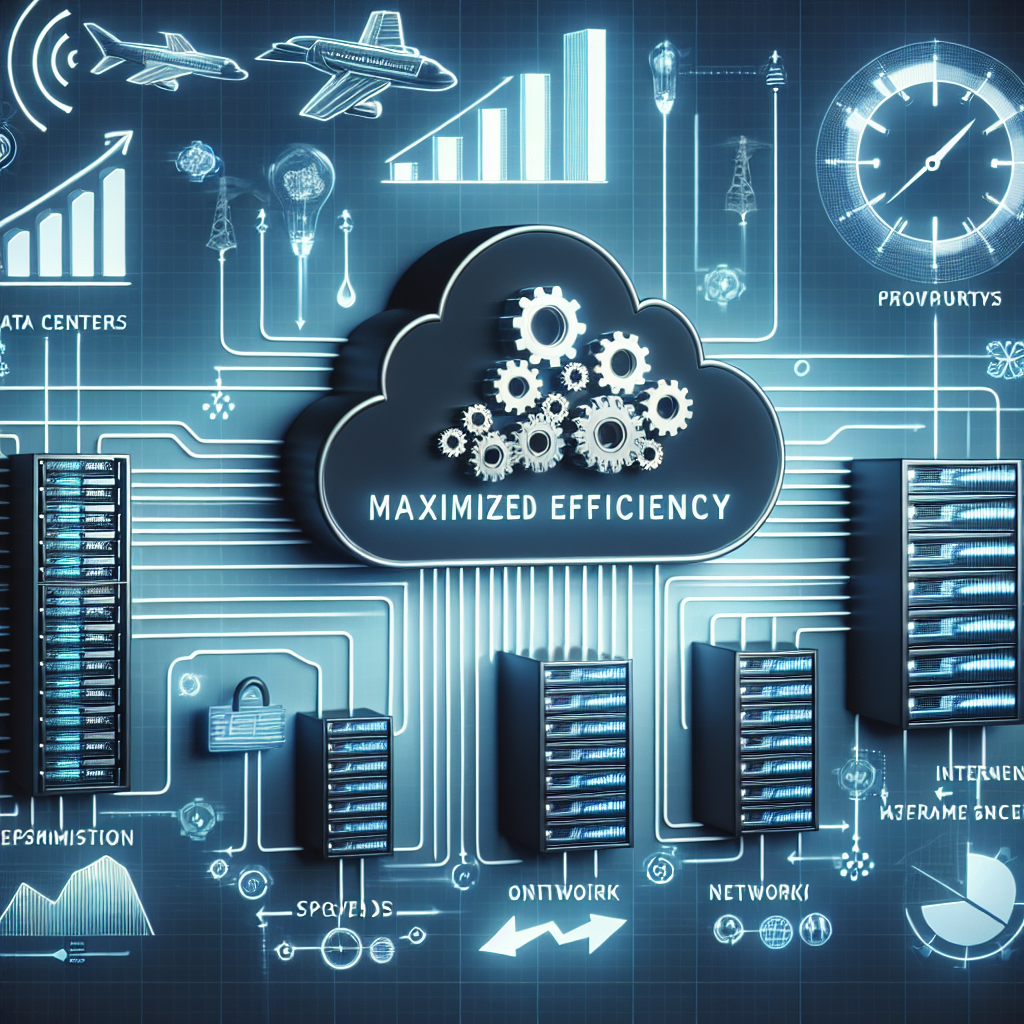Your cart is currently empty!
Tag: IT Solutions

Preparing for the Unexpected: A Guide to Disaster Recovery
Disasters can strike at any moment, leaving businesses and individuals vulnerable and unprepared. Whether it’s a natural disaster like a hurricane, earthquake, or flood, or a man-made disaster such as a cyber attack or data breach, being prepared for the unexpected is crucial for ensuring business continuity and minimizing the impact of a crisis.Disaster recovery planning is the process of creating a plan to respond to and recover from a disaster. This plan outlines the steps that must be taken to protect assets, minimize downtime, and resume operations as quickly as possible. Without a solid disaster recovery plan in place, businesses risk losing valuable data, revenue, and reputation in the event of a crisis.
Here are some key steps to help you prepare for the unexpected and create a comprehensive disaster recovery plan:
1. Identify potential risks: Start by identifying the potential risks that your business may face, such as natural disasters, cyber attacks, power outages, or equipment failure. Conduct a risk assessment to determine the likelihood and impact of each risk on your business.
2. Develop a disaster recovery team: Assign roles and responsibilities to key personnel who will be responsible for implementing the disaster recovery plan. Make sure everyone understands their role and is trained on how to respond in case of an emergency.
3. Create a communication plan: Establish a communication plan to ensure that all employees, customers, and stakeholders are informed of the situation and updates during a disaster. Consider using multiple channels, such as email, phone, text message, and social media, to reach everyone efficiently.
4. Backup data and systems: Regularly backup your data and systems to ensure that critical information is secure and accessible in case of a disaster. Consider using cloud storage or offsite backups for added protection.
5. Test your plan: Regularly test and update your disaster recovery plan to ensure that it is effective and up-to-date. Conduct drills and simulations to identify weaknesses and areas for improvement.
6. Establish partnerships: Establish partnerships with vendors, suppliers, and other businesses to ensure that you have access to resources and support in case of a disaster. Collaborate with local emergency services and authorities to coordinate response efforts.
7. Review insurance coverage: Review your insurance coverage to ensure that you are adequately protected in case of a disaster. Consider adding additional coverage for specific risks that may not be covered by your existing policies.
By taking proactive steps to prepare for the unexpected, businesses can minimize the impact of a disaster and ensure that they are able to recover quickly and resume operations. Remember that disaster recovery planning is an ongoing process that requires regular review and updates to stay effective and relevant in today’s ever-changing business landscape. Stay prepared, stay resilient, and stay safe.

The Ultimate Guide to Data Backup and Recovery Best Practices
Data backup and recovery are essential components of any organization’s IT strategy. In today’s digital age, data is crucial for business operations, and losing it can have severe consequences. That’s why having a solid backup and recovery plan in place is critical to ensure that your data is safe and accessible in case of any disaster or cyberattack.Here is the ultimate guide to data backup and recovery best practices:
1. Identify critical data: The first step in creating a backup and recovery plan is to identify the critical data that needs to be backed up. This includes financial records, customer information, intellectual property, and other essential data that is crucial for the operation of your business.
2. Choose the right backup solution: There are various backup solutions available, including on-premises backups, cloud backups, and hybrid backups. It’s essential to choose the right solution based on your organization’s needs, budget, and security requirements.
3. Implement a regular backup schedule: Consistency is key when it comes to data backup. Make sure to establish a regular backup schedule to ensure that your data is backed up regularly and consistently. This will help minimize data loss in case of any unexpected events.
4. Test your backups regularly: It’s not enough to just back up your data; you also need to test your backups regularly to ensure that they are working correctly. This will help you identify any issues with your backup solution and address them before it’s too late.
5. Encrypt your backups: Data security is crucial when it comes to backups. Make sure to encrypt your backups to protect your data from unauthorized access. This will help prevent data breaches and ensure that your data is safe and secure.
6. Develop a disaster recovery plan: In addition to backups, it’s essential to have a disaster recovery plan in place. This plan should outline the steps to take in case of a data loss event, such as a cyberattack or natural disaster. Make sure to test your disaster recovery plan regularly to ensure that it is effective in case of an emergency.
7. Train your employees: Employees play a crucial role in data backup and recovery. Make sure to train your employees on best practices for data backup and recovery to ensure that they understand the importance of data security and know how to respond in case of a data loss event.
8. Monitor and update your backup solution: Data backup and recovery are not set-and-forget processes. Make sure to monitor and update your backup solution regularly to ensure that it meets your organization’s changing needs and security requirements.
By following these best practices, you can create a robust data backup and recovery plan that will help protect your organization’s data and ensure business continuity in case of any unexpected events. Remember, data is the lifeblood of your organization, so make sure to prioritize data backup and recovery to safeguard your data and keep your business running smoothly.

Why Remote Monitoring is Essential for Ensuring Data Security
In today’s digital age, data security is of utmost importance for businesses of all sizes. With the increasing number of cyber threats and data breaches, it has become crucial for organizations to ensure the security of their sensitive information. One way to achieve this is through remote monitoring.Remote monitoring involves the use of monitoring tools and software to keep track of a company’s network and systems from a remote location. This allows businesses to oversee their IT infrastructure and detect any potential security threats or vulnerabilities in real-time. By monitoring their systems remotely, organizations can take proactive measures to prevent data breaches and ensure the confidentiality and integrity of their data.
There are several reasons why remote monitoring is essential for ensuring data security. One of the main benefits is the ability to detect and respond to security incidents quickly. With remote monitoring, IT teams can receive instant alerts about any suspicious activities or unauthorized access to their systems. This allows them to take immediate action to mitigate the threat and prevent any potential data loss.
Furthermore, remote monitoring helps organizations to identify vulnerabilities in their systems before they can be exploited by cybercriminals. By continuously monitoring their networks and systems, businesses can proactively address any security flaws and implement necessary patches or updates to strengthen their defenses.
Remote monitoring also provides businesses with visibility into their IT infrastructure, even when their employees are working remotely or on-the-go. This is especially important in today’s remote work environment, where employees are accessing company data from various locations and devices. With remote monitoring, organizations can ensure that their data is secure no matter where it is being accessed from.
In addition, remote monitoring can help businesses comply with data security regulations and standards. Many industries are subject to strict data protection laws, such as the General Data Protection Regulation (GDPR) and the Health Insurance Portability and Accountability Act (HIPAA). By implementing remote monitoring, organizations can demonstrate their commitment to data security and ensure that they are meeting regulatory requirements.
Overall, remote monitoring is an essential tool for businesses looking to enhance their data security measures. By continuously monitoring their networks and systems, organizations can detect and respond to security threats in real-time, identify vulnerabilities before they are exploited, ensure data security for remote employees, and comply with data protection regulations. With the increasing number of cyber threats, investing in remote monitoring is a proactive step towards safeguarding sensitive information and maintaining the trust of customers and stakeholders.

How to Choose the Right Technical Support Provider for Your Business
In today’s fast-paced business world, having reliable technical support is crucial for the success of your company. Whether you’re a small startup or a large corporation, having the right technical support provider can make all the difference in keeping your operations running smoothly and efficiently.But with so many options out there, how do you choose the right technical support provider for your business? Here are some key factors to consider when making this important decision:
1. Experience and expertise: One of the most important factors to consider when choosing a technical support provider is their experience and expertise in the field. Look for a provider that has a proven track record of successfully supporting businesses of similar size and industry. Make sure they have the necessary certifications and qualifications to handle your specific technical needs.
2. Range of services: Different businesses have different technical needs, so it’s important to choose a provider that offers a wide range of services to meet your requirements. Whether you need help with network security, data backup, cloud computing, or any other technical issue, make sure the provider you choose can offer the services you need.
3. Response time and availability: When technical issues arise, you need a provider that can respond quickly and efficiently to resolve them. Look for a provider that offers 24/7 support and has a guaranteed response time for critical issues. Make sure they have a dedicated team of technical experts who are available to assist you whenever you need them.
4. Customer reviews and testimonials: Before making a decision, be sure to research the provider’s reputation by reading customer reviews and testimonials. Look for feedback from businesses that have worked with the provider in the past to get an idea of their level of service and customer satisfaction.
5. Cost: While cost shouldn’t be the only factor you consider when choosing a technical support provider, it’s important to find a provider that offers competitive pricing for the services you need. Be sure to get quotes from several providers and compare them to find the best value for your money.
By considering these key factors, you can choose the right technical support provider for your business and ensure that your operations run smoothly and efficiently. With the right support in place, you can focus on growing your business and achieving your goals with confidence.

How to Choose the Right Help Desk Software for Your Business
In today’s digital age, providing excellent customer service is crucial for the success of any business. One of the key tools that can help businesses streamline their customer support process is help desk software. With the right help desk software, businesses can efficiently manage customer inquiries, resolve issues in a timely manner, and improve overall customer satisfaction.But with so many help desk software options available in the market, how do you choose the right one for your business? Here are some factors to consider when selecting help desk software for your business:
1. Define your needs: Before you start looking for help desk software, it’s important to identify your specific needs and requirements. Consider factors such as the volume of customer inquiries, the complexity of the issues you typically deal with, and the size of your customer support team.
2. Ease of use: The best help desk software is user-friendly and easy to navigate. Look for software that offers a clean and intuitive interface, as this will help your customer support team work more efficiently.
3. Customization options: Every business is unique, so it’s important to choose help desk software that can be customized to fit your specific needs. Look for software that allows you to create custom ticket forms, automate workflows, and personalize the user experience.
4. Integration capabilities: Your help desk software should be able to integrate seamlessly with other tools and platforms that your business uses, such as CRM software, email marketing tools, and social media platforms. This will help you streamline your customer support process and provide a more cohesive experience for your customers.
5. Reporting and analytics: To track the effectiveness of your customer support efforts, look for help desk software that offers robust reporting and analytics features. This will allow you to monitor key metrics such as response times, resolution rates, and customer satisfaction scores.
6. Scalability: As your business grows, your customer support needs will likely evolve as well. Choose help desk software that can scale with your business and accommodate your changing needs over time.
7. Customer support: Last but not least, consider the level of customer support offered by the help desk software provider. Look for a provider that offers responsive and helpful customer support, as you may need assistance with setting up the software, troubleshooting issues, or training your team.
In conclusion, choosing the right help desk software for your business is a crucial decision that can have a significant impact on your customer support efforts. By considering factors such as your specific needs, ease of use, customization options, integration capabilities, reporting and analytics features, scalability, and customer support, you can select the best help desk software that will help you provide top-notch customer service and drive business success.

Top Network Management Tools for IT Professionals
In today’s fast-paced and technologically advanced world, IT professionals are constantly facing the challenge of managing and monitoring complex networks to ensure optimal performance and security. To help simplify this task, there are a plethora of network management tools available on the market that can assist IT professionals in effectively managing their networks.Here are some of the top network management tools that IT professionals should consider using:
1. SolarWinds Network Performance Monitor (NPM): SolarWinds NPM is a comprehensive network monitoring tool that provides IT professionals with real-time insights into their network performance. It offers features such as network mapping, bandwidth monitoring, and alerting, making it easy to identify and resolve network issues quickly.
2. PRTG Network Monitor: PRTG Network Monitor is another popular network management tool that offers a wide range of monitoring capabilities, including network traffic analysis, server monitoring, and application monitoring. It also provides customizable dashboards and reports to help IT professionals keep track of their network performance.
3. ManageEngine OpManager: OpManager is a network management tool that offers a unified dashboard for monitoring network devices, servers, and applications. It provides features such as network mapping, performance monitoring, and alerting, making it easy for IT professionals to manage their networks efficiently.
4. Cisco Prime Infrastructure: Cisco Prime Infrastructure is a network management tool specifically designed for Cisco devices. It offers features such as configuration management, performance monitoring, and wireless network management, making it an ideal choice for IT professionals managing Cisco networks.
5. Nagios XI: Nagios XI is an open-source network monitoring tool that offers a wide range of monitoring capabilities, including network, server, and application monitoring. It also provides customizable dashboards and alerting features to help IT professionals stay on top of their network performance.
These are just a few of the top network management tools available to IT professionals. By utilizing these tools, IT professionals can effectively monitor and manage their networks to ensure optimal performance and security. Whether you are managing a small office network or a large enterprise network, investing in a reliable network management tool can help streamline your network management tasks and improve overall efficiency.

Cybersecurity Best Practices for Businesses and Individuals
In today’s digital age, cybersecurity has become more important than ever before. With the rise of cyber threats such as hacking, ransomware, and data breaches, businesses and individuals must take proactive measures to protect their sensitive information and data. Cybersecurity best practices are essential for safeguarding against these threats and ensuring the security and privacy of your online activities.For businesses, implementing cybersecurity best practices is crucial to protect their sensitive data, intellectual property, and customer information. A data breach can have severe consequences, including financial loss, damage to reputation, and legal implications. To prevent such incidents, businesses should prioritize cybersecurity and invest in robust security measures.
One of the most important cybersecurity best practices for businesses is to regularly update their software and systems. Outdated software can be vulnerable to cyber attacks, so it is essential to install security patches and updates promptly. Additionally, businesses should use strong, unique passwords for all accounts and implement multi-factor authentication to add an extra layer of security.
Training employees on cybersecurity best practices is also essential for businesses. Employees are often the weakest link in cybersecurity, as they can unknowingly fall victim to phishing scams or other social engineering tactics. By educating employees on how to recognize and respond to potential threats, businesses can significantly reduce the risk of a cyber attack.
For individuals, practicing cybersecurity best practices is equally important. With the increasing amount of personal information being shared online, individuals are at risk of falling victim to identity theft, fraud, and other cyber crimes. By following simple security measures, individuals can protect themselves from potential threats and keep their personal information safe.
One of the most important cybersecurity best practices for individuals is to use strong, unique passwords for all accounts. Using the same password for multiple accounts can make it easier for hackers to gain access to your sensitive information. Additionally, individuals should be cautious about the information they share online and be wary of suspicious emails, links, and attachments.
Regularly updating software and devices is also crucial for individuals to protect against cyber threats. Outdated software can be vulnerable to security vulnerabilities, so it is essential to install updates promptly. Using antivirus software and a firewall can add an extra layer of protection against malware and other cyber threats.
In conclusion, cybersecurity best practices are essential for businesses and individuals to protect against cyber threats and safeguard sensitive information. By implementing security measures such as updating software, using strong passwords, and educating employees, businesses can reduce the risk of a data breach. Similarly, individuals can protect themselves by being cautious online, using strong passwords, and keeping their software up to date. By prioritizing cybersecurity and following best practices, businesses and individuals can mitigate the risks of cyber attacks and ensure the security and privacy of their online activities.

Maximizing Efficiency with Cloud Computing Strategies
In today’s fast-paced business world, efficiency is key to staying competitive and meeting customer demands. One strategy that can help businesses maximize their efficiency is cloud computing. Cloud computing refers to the delivery of computing services – including storage, processing power, and applications – over the internet. By leveraging cloud technology, businesses can streamline their operations, reduce costs, and improve productivity. Here are some strategies for maximizing efficiency with cloud computing.1. Scalability: One of the key benefits of cloud computing is scalability. With cloud services, businesses can easily scale up or down their computing resources based on their needs. This means they can quickly adapt to changes in demand, ensuring that they always have the right amount of resources to support their operations. By leveraging this scalability, businesses can avoid over-provisioning or under-provisioning their IT infrastructure, thereby saving costs and maximizing efficiency.
2. Automation: Cloud computing enables businesses to automate various tasks and processes, such as infrastructure provisioning, application deployment, and data backup. By automating these processes, businesses can reduce manual intervention, minimize errors, and improve consistency. This not only saves time and effort but also ensures that tasks are carried out efficiently and accurately.
3. Collaboration: Cloud computing facilitates collaboration among team members by providing access to shared resources and applications from anywhere, at any time. This enables employees to work together on projects, share documents, and communicate in real-time, regardless of their location. By fostering collaboration, businesses can improve communication, enhance productivity, and accelerate decision-making processes.
4. Data analytics: Cloud computing offers powerful tools and services for data analytics, enabling businesses to derive valuable insights from their data. By analyzing data stored in the cloud, businesses can gain a better understanding of their customers, identify trends, and make informed decisions. This can lead to improved business strategies, better customer service, and increased profitability.
5. Disaster recovery: Cloud computing provides businesses with robust disaster recovery capabilities, ensuring that their data is safe and accessible in the event of a disaster. By storing data in the cloud, businesses can easily recover from data loss or system failures, minimizing downtime and ensuring business continuity. This can help businesses avoid costly disruptions and maintain their operations smoothly.
In conclusion, cloud computing offers businesses a wide range of benefits for maximizing efficiency. By leveraging scalability, automation, collaboration, data analytics, and disaster recovery capabilities, businesses can streamline their operations, reduce costs, and improve productivity. As technology continues to advance, cloud computing will play an increasingly important role in helping businesses stay competitive and meet the demands of the digital age.

Navigating the Digital Landscape: IT Solutions for Modern Businesses
In today’s fast-paced digital world, businesses are constantly faced with the challenge of navigating the ever-evolving digital landscape. With technology advancing at an unprecedented rate, it is crucial for businesses to stay ahead of the curve and adopt the right IT solutions to keep up with the competition.One of the key challenges that businesses face in the digital landscape is ensuring that their IT infrastructure is up to date and capable of supporting their operations. This includes everything from hardware and software to network security and data storage. With the increasing amount of data being generated and processed by businesses, it is essential to have robust IT solutions in place to manage and protect this valuable information.
Cloud computing has emerged as one of the most popular IT solutions for modern businesses. By leveraging the power of the cloud, businesses can access scalable and flexible computing resources on demand, without the need for expensive hardware investments. This allows businesses to streamline their operations, improve collaboration, and reduce costs.
Another important aspect of navigating the digital landscape is ensuring that businesses have robust cybersecurity measures in place. With cyber threats becoming more sophisticated and prevalent, it is essential for businesses to invest in cybersecurity solutions to protect their sensitive data and mitigate the risk of cyber attacks. This includes implementing firewalls, encryption, and regular security audits to identify and address vulnerabilities.
Furthermore, businesses can benefit from adopting digital marketing solutions to reach their target audience and drive growth. By leveraging social media, email marketing, and search engine optimization, businesses can effectively promote their products and services, engage with customers, and build brand awareness.
Overall, navigating the digital landscape requires businesses to stay agile and adaptable in the face of constant technological advancements. By investing in the right IT solutions, businesses can maximize their efficiency, productivity, and competitiveness in today’s digital economy. Whether it is cloud computing, cybersecurity, or digital marketing, businesses must prioritize IT solutions to thrive in the modern business landscape.

Choosing the Right IT Outsourcing Partner: Tips for Success
In today’s fast-paced digital world, many businesses are turning to IT outsourcing to help manage their technology needs. Outsourcing can offer numerous benefits, such as cost savings, access to specialized expertise, and increased flexibility. However, choosing the right IT outsourcing partner is crucial to the success of your business. Here are some tips to help you find the perfect partner for your IT needs.1. Define your requirements: Before you start looking for an IT outsourcing partner, it’s important to clearly define your requirements. Consider what specific services you need, what level of expertise you require, and what your budget constraints are. Having a clear understanding of your needs will help you narrow down your options and find a partner that can meet your expectations.
2. Research potential partners: Once you have a clear idea of what you need, start researching potential IT outsourcing partners. Look for companies that have experience in your industry, a strong track record of success, and positive reviews from past clients. You can also ask for recommendations from other businesses in your network or seek out referrals from industry associations.
3. Evaluate their expertise: When evaluating potential IT outsourcing partners, consider their level of expertise in the specific services you need. Look for partners who have experience with the latest technologies and a proven track record of delivering high-quality results. You may also want to inquire about their certifications and partnerships with leading technology providers.
4. Consider their communication and responsiveness: Effective communication is crucial when working with an IT outsourcing partner. Make sure to choose a partner who is responsive to your needs, communicates clearly and regularly, and is available to address any issues or concerns that may arise. A good partner should be proactive in keeping you informed about the progress of your project and should be open to feedback and collaboration.
5. Evaluate their security measures: When outsourcing IT services, it’s important to consider the security measures that your partner has in place to protect your data and systems. Make sure to ask about their data security practices, including encryption protocols, access controls, and disaster recovery plans. A reputable IT outsourcing partner should have robust security measures in place to safeguard your sensitive information.
6. Negotiate the terms of the agreement: Once you have selected a potential IT outsourcing partner, take the time to negotiate the terms of the agreement. Make sure to clarify the scope of work, pricing structure, service level agreements, and any other important details. It’s also a good idea to include provisions for addressing potential issues or disputes that may arise during the course of your partnership.
Choosing the right IT outsourcing partner is a critical decision that can have a significant impact on the success of your business. By following these tips and conducting thorough research, you can find a partner that meets your needs, delivers high-quality results, and provides a strong foundation for your technology strategy.
